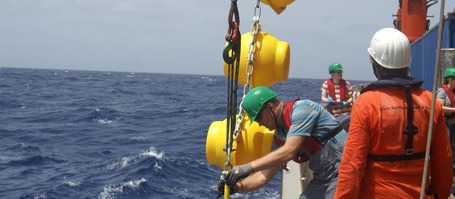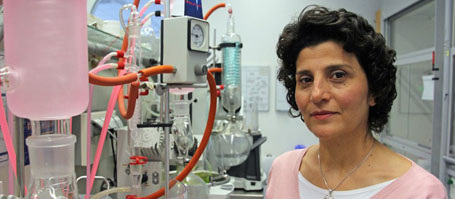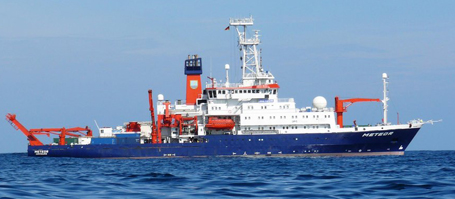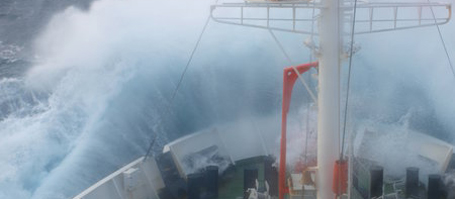The study was developed within the framework of the Collaborative Research Center 754 on deoxygenated zones in the tropical oceans, located at Kiel University and GEOMAR Helmholtz Centre for Ocean Research Kiel. Oxygen is one of the most important foundations for life on our planet – as well as for marine creatures. However, wide areas stretch out on the eastern margins of the tropical oceans, in which considerably lower concentrations of oxygen can be found at a hundred meters depth: These are oxygen minimum zones (OMZ). These zones come into existence because the supply of oxygenated waters is not very effective here and in addition microbiological processes use a relatively high amount of oxygen.
However, the OMZ in the tropical North Atlantic is not as strongly pronounced as the significantly larger one in the Pacific. For the first time, scientists from the GEOMAR Helmholtz Centre for Ocean Research Kiel, the University of Bremen and Dalhousie University in Canada report the existence of zones which are extremely low in oxygen in the open tropical North Atlantic, hundreds of kilometers away from the African coast. These areas, which cover a surface about half as big as the region of Schleswig-Holstein, can be found close to the ocean’s surface. They form in gigantic vortices, which occur in nearly all areas of the world’s oceans. However, fortunately only a few of these fulfill the conditions for the formation of a low oxygen zone. The scientists will publish the results in the international journal Biogeosciences.
After the scientists detected a vortex low in oxygen at a long-term measuring station, the “Cape Verde Ocean Observatory” north of the Cape Verde Islands, they were able to follow the vortices from their formation off the coast of Africa to the west of the Cape Verde Islands with the help of a combination of different modern measuring systems, among them satellites and freely floating measuring probes. “We were already aware that vortices are being formed off the coast of Africa, which migrate towards the West across the Atlantic”, explains Dr. Johannes Karstensen from GEOMAR, first author of the current study. “But we were really surprised about the extent of the oxygen deficiency within them”.
The vortices which host the oxygen-deficient zones form due to changing currents off the West African coast. At first, they do not yet have particularly low concentrations of oxygen, but are rich in nutrients, which in combination with light stimulate strong plankton growth. The plankton forms a dense carpet near to the surface, through which hardly any light reaches the deeper layers. Underneath the plankton carpet, dead organic particles sink, which will be decomposed by bacteria. In doing this they consume the available oxygen. Since hardly any exchange takes place between the vortices and the surrounding ocean water, oxygen transfer from the outside does not happen either. “This explains the extremely low concentrations of oxygen near to the surface”, says Dr. Karstensen. The process resembles the formation of “dead zones“, which is known to happen in inland lakes and coastal areas – which up to now, however, has not been observed in the ocean.
“We now have the first proof that these vortices themselves produce oxygen-deficient to oxygen-free conditions and that they do not simply transport it along from the coastal region into the open ocean”, explains the oceanographer from Kiel. Finally, on their way to the Atlantic the vortices dissolve and mix with the surrounding water. Further studies should investigate the role the vortices play in the total North Atlantic oxygen budget, how organisms react to oxygen-deficient zones and what happens if theses vortices collide with an island chain, for example with the Cape Verde Islands.
Original work:
Karstensen, J., B. Fiedler, F. Schütte, P. Brandt, A. Körtzinger, G. Fischer, R. Zantopp, J. Hahn, M. Visbeck, D. Wallace (2015): Open ocean dead zones in the tropical North Atlantic Ocean, Biogeosciences, 12, 2597-2605, http://dx.doi.org/10.5194/bg-12-2597-2015
Background information:
The Collaborative Research Center 754 (SFB 754) "Climate-Biogeochemistry Interactions in the Tropical Ocean" was founded as a cooperation between Kiel University (CAU), the GEOMAR Helmholtz Center For Ocean Research Kiel and the Max Planck Institute Bremen. The SFB 754 studies the changes of the oceanic oxygen concentration, their potential impact on the oxygen minimum zones and the consequences for the global interplay between the climate and the biochemistry of the tropical ocean. The SFB 754 is supported by the German Research Foundation (DFG) and is in its second phase (2012-2015).
Contact:
Jan Steffen (GEOMAR, Communication & Media), Tel.: 0431 600-2811, presse(at)geomar.de
…



